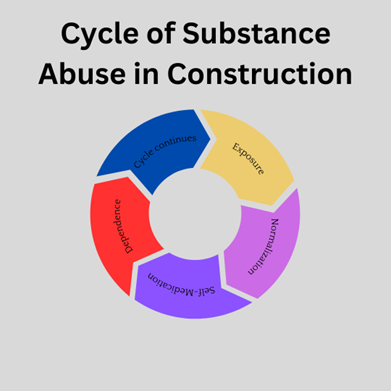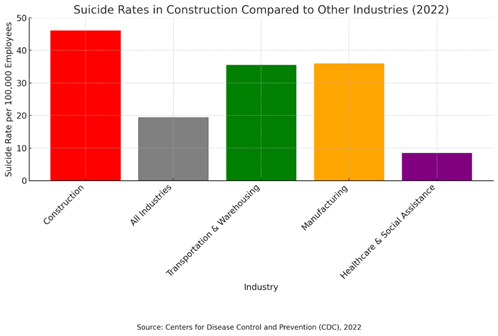Mental Health and the Glazing Industry
How we can break the stigma
The work environment, mental health stigma, substance abuse, addiction, and, ultimately, high suicide rates demand the attention of the construction industry— including glaziers, installers, technicians, helpers and apprentices. This sequence shows the pathway some may follow when their well-being goes unnoticed by coworkers and management. Recognizing signs of distress early on can save lives.
Here are some of the main issues, using data to highlight their urgency.
Work environment and stigma
For many, time at work may outweigh time with family and friends. In a standard 168-hour week:
- Work hours: around 40 hours (8 hours per day)
- Sleep: 56 hours (8 hours per night)
- Commute: 10 hours (1 hour each way, 5 days a week)
That leaves about 62 hours for personal time, including time at home. With overtime, many construction workers spend more time away from home than at home. This showcases how meaningful the relationships at work are to a person’s overall well-being.
Unfortunately, some construction sites are not a friendly place. Whether it be hazing, aggressive behavior, physical intimidation, or unsafe and harsh working conditions, many challenging and toxic contributors can negatively affect mental health. There is a stigma in the construction field that prevents workers from seeking help for things that may be construed as weaknesses. This needs to change before we can reduce suicide and addiction rates.
With over 15 years in the field, working as a glazier, I’ve seen firsthand how the attitudes on construction sites would never be okay in other settings. This challenging culture can leave lasting negative impressions, especially on young workers.
Ways to transform the culture:
- Train all employees, from executives to apprentices, on mental health, addiction, and suicide risk to better identify and address these issues.
- Ensure superintendents and forepersons understand mental health and addiction so they can intervene early.
- Integrate cultural awareness into toolbox talks, meetings, safety briefs, and team-building events to foster a healthier workplace.
- To address industry-specific challenges, provide counseling services through partnerships, Employee Assistance Programs (EAPs), or union programs (e.g., IUPAT Helping Hands).
Just as safety standards have evolved over the last 20 years, we can improve mental health and addiction support in construction. Talking about these issues openly could save lives.
Substance abuse and addiction
 Glaziers and installers may use alcohol or drugs as coping mechanisms, often due to high physical demands, irregular work hours, self-medicating injuries, and mental strain. Approximately 15% of all construction workers have a substance use disorder, compared to 8.6% of the general population (Bush & Lipari, 2015, Substance Use and Substance Use Disorder by Industry). About 1.3% of construction workers have an opioid use disorder, nearly twice the national average, according to a report from the National Safety Council. Additionally, construction workers are seven times more likely to die of an opioid overdose than workers in other industries (The Plain Dealer, 2017).
Glaziers and installers may use alcohol or drugs as coping mechanisms, often due to high physical demands, irregular work hours, self-medicating injuries, and mental strain. Approximately 15% of all construction workers have a substance use disorder, compared to 8.6% of the general population (Bush & Lipari, 2015, Substance Use and Substance Use Disorder by Industry). About 1.3% of construction workers have an opioid use disorder, nearly twice the national average, according to a report from the National Safety Council. Additionally, construction workers are seven times more likely to die of an opioid overdose than workers in other industries (The Plain Dealer, 2017).
Possible solutions:
- Normalize conversations about addiction in toolbox talks, meetings, and team-building events to keep these issues open and approachable.
- Share information on recovery meetings and support groups, making them accessible both on-site and locally.
- Provide on-site counseling and addiction support resources through partnerships, Employee Assistance Programs (EAPs), or union programs (e.g., IUPAT Helping Hands).
Suicide rates in construction
There is a suicide issue in the construction industry with consistent findings across the board; multiple studies and reports from leading organizations underscore the mental health crisis among construction workers. According to a recent report, the suicide rate among construction workers in 2022 was 2.4 times higher than the average across all industries, with a rate of 46.1 per 100,000 full-time employees in construction, compared to 19.5 per 100,000 in all industries. Also, there were five times more suicides than at-work fatalities among construction workers that year (Construction Dive, 2024).
Other organizations echo these findings, with the U.S. Department of Labor reporting that men working in construction have a suicide rate approximately four times higher than the general population, making it one of the highest rates among all professions (U.S. Department of Labor, 2021). Similarly, the American Foundation for Suicide Prevention highlights that construction workers lose their lives to suicide at a rate five times higher than the general population (American Foundation for Suicide Prevention, 2024).
 Possible solutions:
Possible solutions:
- Train leadership, field, and office staff to recognize mental health issues.
- Designate a mental health champion in the workplace to better communicate around these issues.
- Provide counseling and therapy services via EAPs or union programs (e.g., IUPAT Helping Hands).
- Offer mental health days and flexibility.
- Create a supportive workplace culture that prioritizes mental health and well-being.
The mental health crisis in the construction and glazing industries is real and demands urgent attention. With high rates of substance abuse, addiction, and suicide, it’s clear that change isn’t just beneficial; it’s essential. We can create a healthier and more productive work environment by recognizing signs of distress, reducing stigma, and providing resources like counseling, peer support, and flexible policies. Let’s make it our mission to break the cycle and ensure those who build and shape our world have the support they need.


